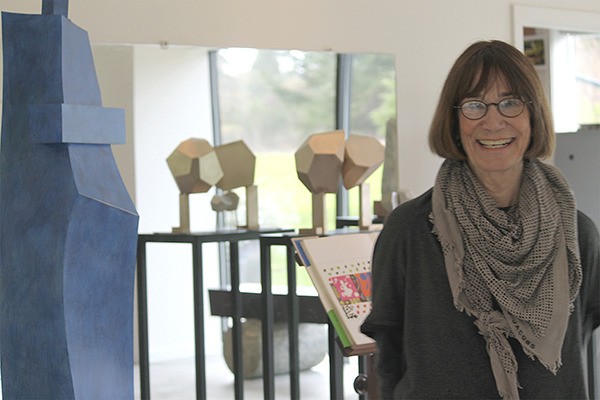Julie Speidel’s studio sits on a rolling piece of land that runs along the spine of the island.
When the Vashon glacier finally relinquished its frozen hold on Puget Sound 15,000 years ago, it deposited in its wake a scattering of geologic calling cards — irregular boulders or glacial erratics. And it left one for Speidel.
Little did the internationally acclaimed sculptor know when she discovered the ancient missive behind her studio that it would eventually become the muse for “Kinetic Repose,” Speidel’s most recent installation for the Tacoma Art Museum (TAM). Last Saturday the museum unveiled the outdoor sculpture, one of three pieces it commissioned for its newly expanded building designed by Olsen Kundig Architects.
Elegant and soft-spoken with a delightful, dry wit, Speidel, 73, is an artist who juggles a busy schedule packed with multiple projects. Her large-scale art requires working with a crew of three professionals to execute her designs. Several outbuildings connect to her spacious studio, and a walk through them reveals a spiraling piece of bronze for a commission still in progress, a tall-ceilinged room used for welding, sanding and painting and at the very back alcove, a stainless steel sculpture inspired by a recent trip to Brittany, France.
Indeed, the larger-than-life piece captures the sway of traditional Breton skirts and jaunty tilt of a lace headdress, but the figure is surprisingly abstract. This intersection of abstract and figurative is familiar territory for Speidel, who wonders out loud whether she’ll paint the metal figure red or perhaps a Breton blue, adding that she has to live with colors a little bit before deciding.
Back in the studio, a light-filled converted horse barn, Speidel points to an outside area, where the source of her inspiration once laid in repose.
“I looked at that glacial erratic for a long time and finally had the wits to use it. I cut into it and made a bench and then started looking at the erratics around the island. Sometimes I’d see a dog sitting on top of one,” Speidel said with a laugh.
A TAM press release describes Speidel’s artistic interpretation of the boulders as “simultaneously referring to the local culture and natural history, inviting the viewer to contemplate the prehistoric past, while experiencing it in the here and now.”
Speidel said she used what the glacier left behind as reference for her artistic license. Once she had the concept, then came the construction. To make the models, Speidel began with a small wooden shape, refined it with a belt sander, scanned and printed in 3-D, cut it with a water jet and finally, carefully, labeled each piece.
The detail is exacting, something Speidel’s assistant Kamela Trujillo helps keep in order when she is not doing a myriad of other jobs, like fielding phone calls about current projects and future commissions. Speidel is also working on a large outdoor sculpture to be installed in the rapidly developing South Lake Union area, and she is waiting to hear from Houston about a contract for another series of erratics.
As with all of her work, the two benches and six brightly painted stainless steel pieces that make up “Kinetic Repose” were welded and sanded in the studio. Speidel and her crew worked with the museum’s structural engineers to calculate the depth for the inserts to hold the sculptures upright. Speidel made sure her crew knew how to work the forklift to lift them into place. The largest piece of the work, which they jokingly call Big Red, is over 13 feet tall and weighs 2,300 pounds.
“Some people buy beautiful cars, but I buy a forklift,” she said. “All my guys have taken the training. My crew is amazing.”
Speidel believes her intrigue with size and three dimensions came about from working with sculpture, but also sites her surroundings as a child growing up in Europe.
“My stepfather was a geologist and we would drive around Scotland and go out to the island looking at the geology, and then I went to college in the mountains of France. All these influences go into you in a way that is hard to separate.”
Closer to home, Speidel credits her awareness of how glaciers carved — or sculpted — the Northwest, noting the Vashon glacier stretched from Whidbey Island to Olympia and scoured Puget Sound 600 feet deep in places, something, she added, humans did not and could not do.
“Every time I cross the water, I look around me and find inspiration,” she said. “I believe people everywhere and throughout time have shared the basic instinct to represent the world around them using symbols and images.”
Speidel’s images seem to strike that universal resonance. Her artwork now sells in galleries in London, New York, California, Colorado, Idaho, Palm Desert and Seattle. Her CV runs 13 pages long and lists work held in prestigious private and public collections abroad and in the U.S., plus solo and group shows dating back to the 1970s. On Vashon, her sculptures can be seen at Ober Park and on Vashon Highway, where a commission called “The Gathering” sits outside Courthouse Square.
In spite of Speidel’s worldly connections, her heart lies with Vashon. She spent summer vacations visiting the island, where her father and grandfather owned property along Colvos Passage, land they found — according to a colorful family legend — by rowboat.
“Vashon is my spiritual home,” Speidel said. “There are not many places like this in the world. To have the friends and surroundings, the calm of this place, we are very lucky.”
The office phone rings, breaking through the serenity of the studio. Trujillo answers and then motions to Speidel. It’s Houston calling with a green light.
“Oh, and Kamela,” Speidel quietly added before picking up the receiver. “Let’s paint the Breton dancer blue.”


